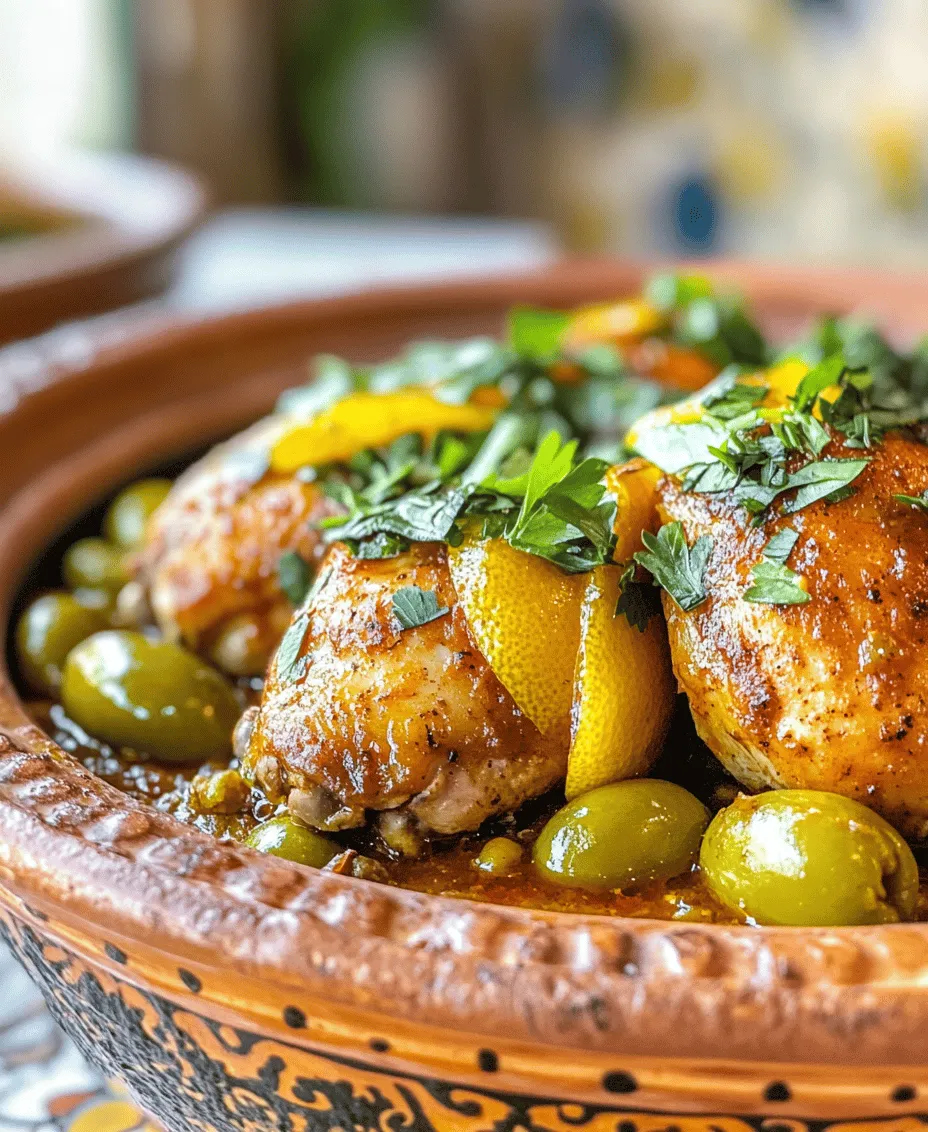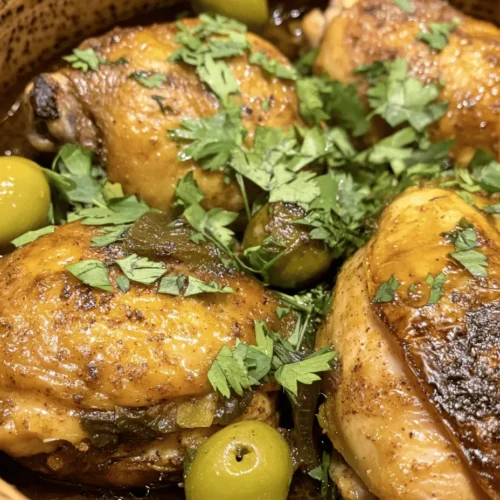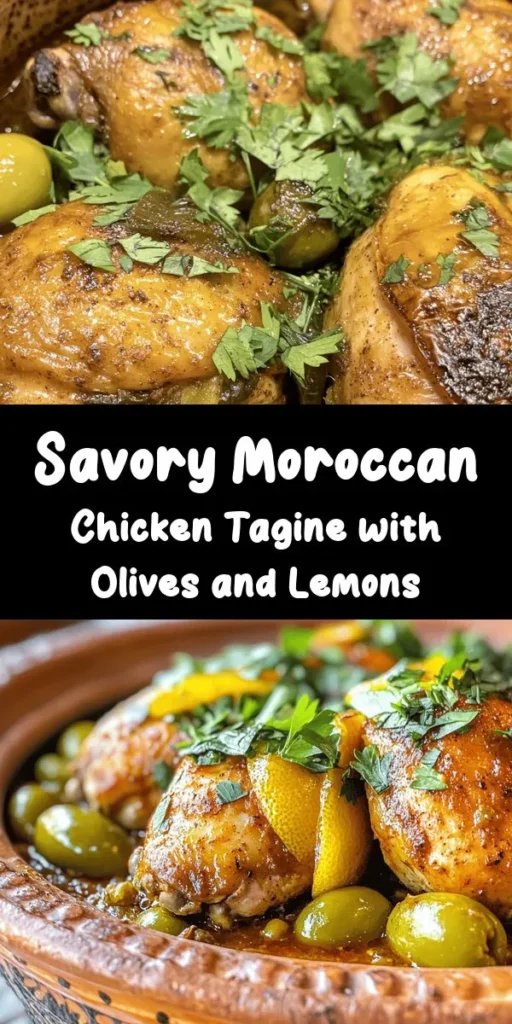Introduction
Moroccan cuisine is renowned for its vibrant flavors, aromatic spices, and intricate culinary techniques that reflect the rich tapestry of cultural influences from Africa, the Mediterranean, and the Middle East. Among its many culinary treasures, Moroccan Chicken Tagine with Olives and Preserved Lemons stands out as a quintessential dish that embodies the essence of this North African culinary heritage.
The term “tagine” refers not only to the earthenware pot used for cooking but also to the delicious slow-cooked stews that emerge from it. This particular chicken tagine showcases the harmony of flavors achieved through a careful selection of ingredients, each contributing to a unique and unforgettable taste experience. The addition of olives and preserved lemons is what truly elevates this dish, introducing a delightful brininess and tang that perfectly balances the savory elements.
As you embark on this culinary adventure, you will explore the intricacies of Moroccan Chicken Tagine, from understanding the significance of the cooking vessel to learning how to prepare each component for a dish that not only satisfies the palate but also nourishes the soul.
Understanding Tagine Cooking
At the heart of Moroccan cuisine lies the tagine, a traditional cooking vessel made from clay or ceramic, characterized by its conical lid that promotes a unique cooking process. This design allows for steam to circulate within the pot, resulting in tender, flavorful dishes that are both moist and aromatic. The tagine is more than just a cooking tool; it is a symbol of Moroccan culture, often used during family gatherings and special occasions, reflecting the importance of communal dining in Moroccan society.
Cooking in a tagine is an art form that requires patience and an understanding of flavor development. Unlike conventional cooking methods, where high heat is often employed, tagine cooking relies on low and slow heat. This method allows the spices to bloom and the ingredients to meld together, creating a depth of flavor that is characteristic of Moroccan dishes. The gentle heat ensures that the chicken remains succulent while allowing the vegetables to soften and absorb the aromatic spices.
Using a tagine offers several benefits over other cooking methods. Firstly, it preserves the moisture of the ingredients, reducing the need for excessive oil and enhancing the natural flavors of the chicken, olives, and preserved lemons. Secondly, the tagine’s design encourages an even distribution of heat, allowing for consistent cooking throughout the dish. Finally, the presentation of a tagine is a feast for the eyes, making it a stunning centerpiece for any dining table.
Ingredients Breakdown
To create a truly authentic Moroccan Chicken Tagine, selecting the right ingredients is crucial. Each component plays a vital role in building layers of flavor that are essential to this dish.
Chicken Thighs
When it comes to chicken for tagine, bone-in, skin-on thighs are the preferred choice. The rich, dark meat of the thighs is more forgiving during the slow cooking process, remaining moist and tender, while the skin adds a layer of flavor and richness that enhances the overall dish. The bones contribute to a deeper taste, especially as the tagine simmers and the flavors meld together.
Olive Oil
Olive oil is a staple in Moroccan cooking, prized not only for its rich flavor but also for its health benefits. Rich in monounsaturated fats and antioxidants, olive oil contributes to heart health and adds a distinct fruity note to the dish. In this recipe, it is used to sear the chicken and sauté the aromatics, laying the foundation for the complex flavors that will develop throughout the cooking process.
Aromatics
Aromatic ingredients such as onions and garlic form the backbone of Moroccan Chicken Tagine, providing a fragrant base that elevates the dish. Onions, when sautéed, become sweet and caramelized, while garlic imparts a pungent kick that complements the spices. Together, they create a savory foundation that enhances the overall depth of flavor in the tagine.
Spices
The spices used in Moroccan cooking are what set it apart from other cuisines. In this dish, you’ll find a blend of ginger, cumin, cinnamon, paprika, and saffron, each contributing its unique character to the overall flavor profile.
– Ginger adds warmth and a slight zing, balancing the richness of the chicken.
– Cumin provides an earthy depth that is quintessential in Moroccan dishes.
– Cinnamon introduces a hint of sweetness and warmth, making it a common ingredient in savory dishes.
– Paprika adds a mild smokiness and a vibrant red color, enhancing the visual appeal of the dish.
– Saffron, though used sparingly due to its cost, infuses a luxurious flavor and a golden hue that elevates the overall experience.
Olives and Preserved Lemons
Perhaps the most distinctive elements of this Moroccan Chicken Tagine are the olives and preserved lemons. These ingredients are not merely additions; they are integral to the dish’s character.
– Olives bring a briny, savory flavor that contrasts beautifully with the sweetness of the caramelized onions and the spices. Green olives are typically used, providing a sharp, tangy note.
– Preserved lemons offer an intense citrus flavor that is both tangy and salty. The preservation process softens the rind and develops a complex flavor that enhances the dish’s overall profile. They are a staple in Moroccan cooking, adding a unique twist to various dishes.
Chicken Broth and Tomatoes
To create a rich sauce that envelops the chicken and vegetables, chicken broth and tomatoes are essential. The broth provides a savory base, while the tomatoes add acidity and sweetness, balancing the overall flavor. Together, they create a luscious sauce that can be spooned over couscous or served alongside crusty bread, making for a satisfying meal.
Preparation Steps Explained
Now that we’ve explored the ingredients, it’s time to dive into the preparation steps that will guide you in creating the perfect Moroccan Chicken Tagine.
Step 1: Seasoning the Chicken
Begin by generously seasoning the chicken thighs with salt and pepper. This step is crucial as it enhances the natural flavor of the meat. Allow the seasoned chicken to sit for about 15-20 minutes at room temperature. This not only helps the seasoning penetrate the meat but also allows the chicken to cook more evenly.
Step 2: Searing the Chicken
In a tagine or a heavy-bottomed pot, heat a few tablespoons of olive oil over medium-high heat. Once the oil shimmers, carefully add the chicken thighs, skin-side down. Searing the chicken is an essential step that develops a golden-brown crust, adding both flavor and texture to the dish. Cook for about 5-7 minutes until the skin is crispy and browned, then flip the thighs and sear the other side for an additional 5 minutes.
After searing, remove the chicken from the pot and set it aside on a plate. This will allow you to build the flavor base without overcrowding the pot.
Step 3: Sautéing the Aromatics
In the same pot, add diced onions and minced garlic, stirring to combine with the residual oil and chicken drippings. Sauté the aromatics over medium heat for about 5-7 minutes until the onions become translucent and start to caramelize. This step is vital to develop the foundational flavors of the tagine.
Step 4: Adding the Spices
Once the onions and garlic are fragrant and golden, it’s time to add the spices. Sprinkle in the ginger, cumin, cinnamon, paprika, and a pinch of saffron. Stir the spices into the onion mixture, allowing them to toast for about a minute. This process releases the essential oils from the spices, intensifying their flavors and infusing the dish with the aromatic essence of Moroccan cuisine.
Step 5: Building the Sauce
After the spices have bloomed, it’s time to add the chicken broth and diced tomatoes to the pot. Stir well to combine, scraping up any flavorful bits stuck to the bottom of the pot. The combination of broth and tomatoes will create a rich sauce that will envelop the chicken during cooking.
Carefully return the seared chicken thighs to the pot, nestling them into the sauce. Scatter the olives and pieces of preserved lemon over the top, ensuring they are evenly distributed. These ingredients will infuse their distinctive flavors into the dish as it simmers.
Step 6: Simmering the Tagine
Bring the mixture to a gentle simmer, then reduce the heat to low. Cover the pot with the lid, allowing the tagine to cook slowly for about 45 minutes to an hour. During this time, the chicken will become tender, and the flavors will meld together beautifully.
As the tagine simmers, the aroma of spices, olives, and preserved lemons will fill your kitchen, transporting you to the bustling streets of Morocco. The patience required in this step is well worth it, as the slow cooking process results in a dish that is rich in flavor and character.
By following these initial steps, you set the stage for a delicious Moroccan Chicken Tagine that will leave your guests impressed and your taste buds dancing. Stay tuned for the next part of this recipe, where we will explore additional tips for perfecting your tagine and answer some common questions about this beloved dish.

Cooking the Aromatics: Enhancing Flavor Profiles
To create a truly authentic Moroccan Chicken Tagine, the first step involves cooking the aromatics, which are essential for building the foundational flavors of the dish. Begin by heating your olive oil in a tagine or a heavy-bottomed pot over medium heat. Once the oil is shimmering, add finely chopped onions, minced garlic, and grated ginger.
Cooking these aromatics slowly allows their natural sugars to caramelize, releasing a sweet and savory aroma that forms the backbone of your tagine. Stir the mixture frequently to prevent burning, ensuring that the onions become translucent and the garlic fragrant without browning too much. This process typically takes around 5 to 7 minutes.
Once the onions are soft, you can introduce a blend of spices that are characteristic of Moroccan cuisine. Cumin, coriander, paprika, and a pinch of cinnamon are traditional staples that not only heighten the dish’s flavor but also contribute to its warmth and complexity. Allow the spices to toast for a couple of minutes, which will enhance their flavors and release their essential oils. This step is crucial as it prepares your palate for the rich, layered tastes that will follow.
Incorporating the Chicken and Broth: Creating a Rich Sauce
With the aromatics beautifully sautéed and fragrant, it’s time to incorporate the chicken. Use bone-in, skin-on chicken pieces for the best flavor and tenderness. Season the chicken generously with salt and pepper before adding it to the pot. Sear the chicken on all sides until it develops a golden-brown crust, which will lend a deeper flavor to the final dish. This should take about 5 to 8 minutes.
Once the chicken is browned, pour in chicken broth or stock, ensuring that the pieces are partially submerged. The liquid not only helps to cook the chicken but also creates a rich sauce that will absorb the spices and aromatics. Bring the mixture to a gentle simmer, scraping the bottom of the pot to deglaze any flavorful bits that may have stuck during the searing process.
At this stage, don’t forget to add a touch of honey or brown sugar to balance the dish’s savory and spicy elements. This sweetness will complement the acidity of the preserved lemons and the briny flavor of the olives, harmonizing all the components into a cohesive sauce.
Adding Olives and Lemons: Balancing Flavors and Textures
Once your chicken is simmering away, it’s time to add the star ingredients: olives and preserved lemons. The olives contribute a briny, savory bite that contrasts beautifully with the richness of the chicken and the sweetness of the spices. Green olives are traditionally used, but you can also experiment with black olives for a different flavor profile.
Before adding the preserved lemons, rinse them under cold water to remove excess salt, then cut them into wedges or strips. Their bright, tangy flavor will infuse the dish, providing a sharp note that balances the overall richness. Stir in the olives and preserved lemons, ensuring they are evenly distributed throughout the sauce.
Let the mixture simmer for an additional 15 to 20 minutes, allowing the flavors to meld together. The vibrant colors and aromas will begin to fill your kitchen, creating an inviting atmosphere that speaks of Moroccan warmth and hospitality.
Slow Cooking: Essential for Tenderness and Flavor Infusion
The key to achieving tender, flavorful chicken in your Moroccan Tagine lies in the slow cooking process. Once all ingredients are combined, reduce the heat to low, cover the tagine with its lid, and let it cook gently for about 1.5 to 2 hours. The slow-cooking method allows the chicken to braise and absorb the aromatic flavors of the broth, spices, olives, and lemons.
This technique is essential for breaking down the connective tissues in the chicken, resulting in a fall-off-the-bone tenderness. The slow simmering also enhances the depth of flavors, as the ingredients have time to mingle and infuse their essences into the sauce.
If you’re using a traditional tagine, you can place it in the oven at a low temperature for a more even cooking experience. Alternatively, if you’re short on time, a pressure cooker can be used to achieve similar tender results in a fraction of the time.
Serving Suggestions
Serving Moroccan Chicken Tagine is an experience that celebrates the flavors of the dish and the culture from which it originates. Here are some traditional accompaniments to elevate your meal:
Couscous: Preparing and Serving
Couscous is the quintessential side dish for Moroccan tagine. To prepare it, bring water or chicken broth to a boil in a saucepan. For every cup of couscous, use approximately 1.5 cups of liquid. Once boiling, stir in the couscous, cover, and remove from heat. Allow it to steam for about 5 minutes, then fluff it with a fork to separate the grains.
Serve the tagine over the couscous, allowing the flavorful sauce to soak into the grains, making each bite a delightful experience. You can also enhance the couscous by mixing in chopped fresh herbs, dried fruits like raisins or apricots, and toasted nuts for added texture and flavor.
Crusty Bread: Soaking Up the Sauce
Another classic accompaniment is crusty bread, perfect for scooping up the tender chicken and rich sauce. A traditional Moroccan bread, such as khobz, is ideal, but any rustic loaf will do. The bread acts as a delightful sponge, soaking up the delicious flavors and adding to the communal aspect of the meal.
Garnishing the Dish: Fresh Herbs
For a finishing touch, garnish your Moroccan Chicken Tagine with fresh herbs, such as cilantro or parsley. Not only do these herbs add a pop of color, but they also contribute a fresh, aromatic note that brightens the dish. Scatter the herbs over the top just before serving, and consider adding a few slices of lemon for a striking presentation.
Nutritional Benefits of Moroccan Chicken Tagine
Moroccan Chicken Tagine is not only a feast for the senses but also a nutritious meal. Here’s an overview of the health benefits of its main ingredients:
– Chicken: As the primary protein source, chicken is rich in lean protein, essential for muscle growth and repair. It is also a good source of important vitamins and minerals, including B vitamins, phosphorus, and selenium.
– Olives: Packed with healthy monounsaturated fats, olives are beneficial for heart health. They also contain antioxidants and anti-inflammatory properties that can help reduce the risk of chronic diseases.
– Preserved Lemons: These add a unique zing to your tagine while providing vitamin C and fiber. The presence of citrus can aid digestion and enhance immunity.
– Vegetables and Spices: The addition of spices like cumin and coriander not only enriches the flavor but also offers numerous health benefits, including anti-inflammatory and digestive support.
This dish allows for customization, making it suitable for various dietary preferences. You can easily adapt it to be gluten-free by serving it with quinoa instead of couscous, or make it vegetarian by substituting the chicken with chickpeas and adding more vegetables.
Cultural Significance of Tagine in Moroccan Cuisine
The tagine is more than just a cooking vessel; it embodies the rich culinary heritage of Morocco. Historically, tagines have been used for centuries, with their unique conical shape designed to promote slow cooking. This method allows flavors to develop fully, making every meal a celebration of taste.
In Moroccan culture, meals are often communal, emphasizing the importance of sharing and togetherness. Tagine dishes are typically served directly from the pot, encouraging everyone to gather around the table and enjoy the meal together. This tradition fosters a sense of community and connection, which is a core aspect of Moroccan hospitality.
Cooking and enjoying tagine can also evoke personal memories and stories. Many families have their own variations of tagine recipes passed down through generations, creating a sense of heritage and continuity. As you prepare and serve Moroccan Chicken Tagine, you may find yourself reflecting on your own experiences and the joy of sharing food with loved ones.
Conclusion
Moroccan Chicken Tagine with olives and preserved lemons is a dish that captivates the senses with its vibrant flavors, enticing aromas, and cultural richness. The intricate layers of spices, the harmony of sweet and savory notes, and the tender chicken create an unforgettable dining experience.
As you try making this recipe at home, you will not only discover the joy of Moroccan cooking but also embrace a tradition that celebrates flavor, community, and togetherness. This tagine encapsulates the essence of Moroccan cuisine, inviting you to savor each bite and share in the warmth of its heritage. So gather your ingredients, roll up your sleeves, and embark on a culinary journey that will transport you straight to the heart of Morocco.



